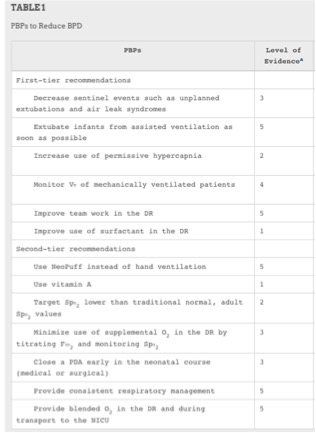On average, the birth of a newborn occurs about 37-40 weeks after conception. It is considered a preterm infant if the baby is born earlier than 37 weeks. Chronic lung disease (CLD) is a serious risk of preterm babies, although consensus among the National Institute of health now refers to it as bronchopulmonary dysplasia (BPD) in order to differentiate the neonatal lung process from the lung diseases that are seen later in life.1
BPD is described as the complication of respiratory distress syndrome (RDS), which include lung immaturity, acute lung injury, and disordered repair of the lung injury. The infant would present with tachypnea, retractions and paradoxical breathing when born. On auscultation, breath sounds would include: rhonchi, rales, and wheezes.2 To reduce a preterm infant’s risk of developing RDS steroids are given two days prior to the infant’s birth if possible After the birth of the infant, surfactant therapy is given prophylactically to improve respiratory function and reduce the risk of RDS and subsequent development of BPD.3
When a preterm infant is delivered, it is very important that the respiratory therapist acts quickly to administer any necessary treatment that the newborn will need, especially to prevent BPD from occurring.
Various practices have been proposed to prevent the incidence of BPD in infants born before 37 weeks of gestation with very low birth weight that present with respiratory distress. A study done by Nathaniel R, et al proposed several potentially better practices to reduce BPD in infants. These potential practices that were considered amongst various hospitals with preterm infants with very low birth weight are shown in Table 1.
Targeting an oxygen saturation that is lower than normal adult values has also been linked to a reduced incidence of BPD.. Also, research has shown that hypocarbia increases the risk of BPD, and therefore, it is preferable to allow permissive hypercapnia along with low tidal volumes to reduce the possibility of lung injury.
Other practices that contribute to the prevention of BPD are early closure of a patent ductus arteriosus, reducing complications such as air leak syndrome, and minimizing the use of supplemental oxygen in the delivery room.4
Since respiratory therapists are responsible for implementing respiratory care procedures such as mechanical ventilation and oxygen therapy, they must have a deep knowledge of these interventions relevant to prevention and treatment of BPD in preterm infants, low birth weight infants, or infants that have some degree of respiratory distress. Appropriate application of these interventions can reduce the incidence of BPD and allow the baby to have the best chance of survival with minimal complications.
Table 1. Nathaniel R, et al. Shows some of the potentially better practices that were considered with infants that presented with low birth weight and respiratory distress.

References
- Walsh BK. Neonatal and Pediatric Respiratory Care. In: , 4th edition edition. St, Louis, Missouri: Saunders; 2015;740:1-11, 416-424.
- Pfister RH, Goldsmith JP. Quality improvement in respiratory care: decreasing bronchopulmonary dysplasia. Clin Perinatol 2010; 37(1): 273-293.
- Bancalari E. Bronchopulmonary Dysplasia: old problem, new presentation. J Pediatr (Rio J) 2006;82(1):2-3.
- Payne NR, LaCorte M, Sun S, Karna P, Lewis-Hunstiger M, Goldsmith JP, et al. Evaluation and development of potentially better practices to reduce bronchopulmonary dysplasia in very low birth weight infants. Pediatrics 2006;118 Suppl 2:S65-S7

As you stated, this is very valuable information for a respiratory therapist to be aware of. Although the therapies we utilize are life-saving for these infants, it is unfortunate that they also cause harm and can lead to BPD. That is why we need to use these therapies judiciously and only when indicated. In research I found, it was proposed that nasal CPAP can also reduce the incidence of BPD. The idea behind it was that it prevents intubation and the negative side effects associated with invasive mechanical ventilation. I also read that if the infant must be invasively mechanically ventilated, volume control is the best mode to prevent BPD. Hopefully in time continuing research will provide us with a more definitive way to prevent BPD.
1. Fischer HS, Buhrer C. Avoiding endotracheal ventilation to prevent bronchopulmonary dysplasia: a meta-analysis. Pediatrics 2013;132(5):e1351-60.
Lauren Harnois, Alex Muller, Anna Kuruc, Urvinder Kaur
LikeLiked by 1 person
I think targeting a lower oxygen saturation is one of the most important strategies to avoid BPD. A lot of people want to use higher concentrations of inspired oxygen in order to achieve higher saturation, but they do not realize it can cause extensive harm to the preterm infant. By making this point stand out on its own, you really emphasize the importance.
LikeLike